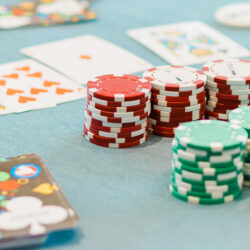
If you’re unfamiliar, check out a brief primer on the Stud 8 rules.
Playing poker with your hand face-up is not very much fun. If you don’t believe it…try it and see! Or think of playing against an opponent whose hand is face-up. Wouldn’t that be fun (and very profitable)?
In poker education, we endlessly preach the virtues of having a “balanced” strategy. By this we mean playing a strategy such that in every betting sequence, we threaten to have a variety of types of hands. When we would value bet, we are also sometimes bluffing. When we flat call, we will sometimes be raising on some future street and so on. The reason for this is precisely because playing with your hand face-up is not very much fun.
In some games, like hold‘em, this is really quite possible. There’s a certain symmetry to that game that makes it very easy to play in a more or less balanced manner with a little thought. This is because each player has two face-down cards, and those cards interact with the community board cards in the same way from player to player. So in some sense, you could “have anything.” Many players have put prodigious numbers of hours into balancing their hand distributions in all common sequences; the result is a strategy that is very hard to read, where they are concealing as much information as they can in the course of the betting. There’s a limit to this, of course, because we want to get extra money in the pot with the best hand. So while it would be difficult to guess the hand of a player who checked and called on every street, that player would probably lose so much that it wouldn’t matter.
Sometimes, though, you might find yourself in a spot where you basically just have to turn your cards over. Consider the following stud 8-or-better hand, which was played in one of our poker classes*:
You: (A♠6♥)2♥
Y: (??)4♦
Z: (??)7♥
(other dead cards: Q♣J♦9♠8♠3♠)
You bring it in, and Y completes directly to your left, first to act. Z then raises after one player folds between them. It’s folded back to you. Both calling and raising are okay here, but let’s say you decide to call. Then Y raises again, Z makes it four bets, and suppose you make it five bets (the cap) and the two others call.
X: (A♠6♣)2♥A♣
Y: (??)4♦A♦
Z: (??)7♥9♣
Great! Now you have a pair of aces and three to a low, and one of your opponents missed. You bet, Y calls, and Z calls.
X: (A♠6♥)2♥A♣6♠
Y: (??)4♦A♦T♠
Z: (??)7♥9♣K♣
This gets better and better. You’ve made aces up. Now both your opponents apparently missed. You almost certainly have the best high hand, and Y is the only one who might have a low draw. Z seems to have missed on both fourth and fifth, so it seems clear to value bet. Y calls. That wasn’t unexpected; he probably has a good low draw. The unexpected thing happens now; Z raises.
Honestly, I wouldn’t have blamed you for mostly forgetting about Z after his fifth street card. It’s hard to see how the cards he’s caught could have helped him and you and Y are both showing decent boards. Now let’s think: What could he have? Remember, five bets went in on third street, and he was doing some of the raising. So he probably started with some premium-ish hand. What could it be? Could he have, say, kings up? It’s hard to see a hand containing one king that would have wanted to put five bets in on third street. So what are we left with? (KK)79K is a candidate. Maybe all those bets against two players with (KK) is a little loose, but it’s at least plausible. Also (77)79K is a candidate, if he waited to get the raise in on fifth. It’s hard to really think of any other hands that he could reasonably have. It’s hard for him to flat-out bluff here, because you could just have a low already, and Y probably has a low draw. And if Z does have trips, it’s hard to blame him for raising here, because while you caught a low card, it’s not a great straight or flush card, and Y missed completely. So if he wants to extract money, now’s the time; he doesn’t want to wait for you to catch even more low cards on the next street, or for Y to catch a low when you have a high hand or pair+low draw.
So now what are your chances against trips? You have two pair, so an ace makes you a better full house. And Y has an ace. So let’s say there’s one ace left in the deck, out of 32 cards. There are probably two sixes left as well, which will win for you most of the time, but not always because the trips might fill up, and when they do, it will cost you extra. Additionally, you might back into a low. Let’s call that one card worth of equity. So say in the end you are going to win the whole pot 1/32 of the time, and win half the pot 3/32 of the time (high or low). The pot contains about 15 big bets. You’re going to have to call bets on at least this street and the next, to win a pot of maybe 18-20 bets. So your equity in the pot is going to be approximately 1.6 bets vs. the two you will have to put in. Now the future action is complicated. Some things are good for you, like when you get extra bets because you’ve made a concealed aces full. Some things are bad for you, like when you make sixes full but lose to kings full, or when you get whipsawed by the high and low on later streets. Nevertheless, you have to make a decision now. And based on this analysis, it seems the right thing to do is to fold.
So we went from being really happy about how the hand was unfolding, and thinking about how to extract the most money from our opponents to folding a pretty strong hand in a big pot in just one action. That’s a lot of information. And even though the action at the table was to raise…the raise was really accompanied by Z turning over his cards.
*details changed




Subscribe Now
Get each new post sent straight to your inbox
We appreciate you taking the time to read our blog and share your feedback. Please be respectful and keep your comments as useful and relevant as possible. We reserve the right to remove comments that contain harassment, offensive language, or are promotional in nature.
Comments are closed.